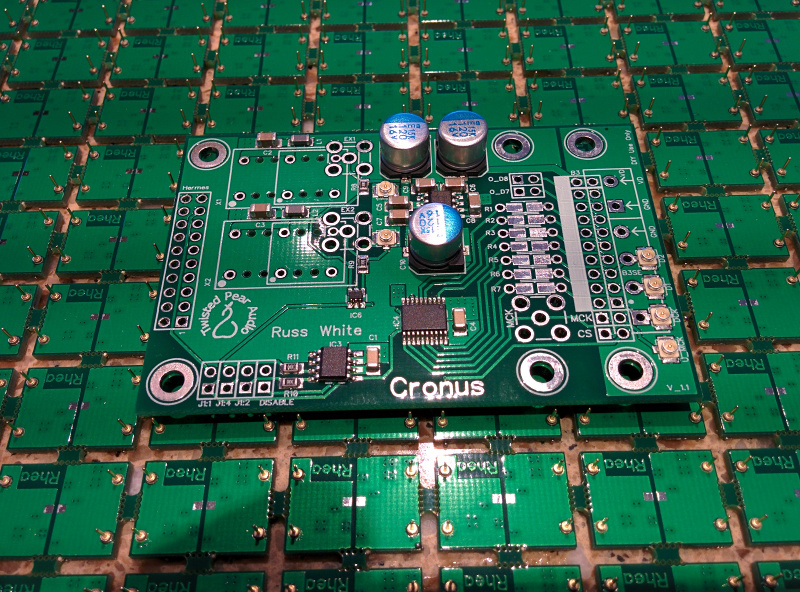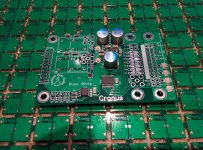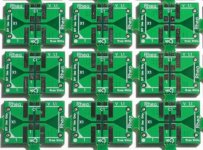Do you have a good picture of the finished and populated Cronus board anywhere?
I'd like to understand power and output connectors.
Also, is the Cronus output isolated or is the isolation just in the hermes?
thanks,
James
I will try to get pictures done tonight, but more likely tomorrow. Also working up some diagrams.
Hi, is possible to use with Buffalo 2 at 384khz?
At this moment I have Amanero+Buffalo 2 how should I integrate?
Thank
Yes, though connecting the external clock is a bit more tricky with the B-II.
1) You need to remove power to the on-board XO, which is done by removing the L3 ferrite on the bottom of the board.
2) You can connect the external XO to the label side of the R17 pads and to GND.
Other than that, you use Amenero with the Hermes-Amenero, connect them to Cronus, then to the B-II input header. There is a separate output for MCK on the Cronus to make the connections noted above.
I'm sorry if I'm way off base here, haven't followed the project that closely, but could Cronus be adapted to be a word clock generator/distributor in a pro audio setting?
I'm sorry if I'm way off base here, haven't followed the project that closely, but could Cronus be adapted to be a word clock generator/distributor in a pro audio setting?
Very possibly - but that was not a design goal.
Very possibly - but that was not a design goal.
Cool thanks, I'll have to follow the project and give it some thought as the documentation develops. Love y'alls stuff btw, my BIII has been singing for a few years now.
Finally! congratulations
congratulations 
I have ordered Cronus and Hermes/rhea. Can't wait till it finally arrives!
Regarding the bbb-pi debate; the new raspberry pi 2 is a quite different board than the old one. There is also much more development (hardware and software) in the Pi camp. So maybe it is worth investigating again.
Regards,
 congratulations
congratulations 
I have ordered Cronus and Hermes/rhea. Can't wait till it finally arrives!
Regarding the bbb-pi debate; the new raspberry pi 2 is a quite different board than the old one. There is also much more development (hardware and software) in the Pi camp. So maybe it is worth investigating again.
Regards,
Thanks to all for the kind words. I can't wait until you get to experience what I am currently experiencing - which is spectacular audio coming from my BBB (and amanero - just not at this very moment)
It will very very cool to hear back from you all.
As for RPI-2 I have four of them. 🙂 I like them a lot. If we can get them to accept an external audio master clock we will be all set - otherwise you really can't do it right - you might as well just use it straight into an ASARC DAC like the B3/B3SE - or use it with our Metronome (that is what I have been doing into a COD and Opus).
It will very very cool to hear back from you all.
As for RPI-2 I have four of them. 🙂 I like them a lot. If we can get them to accept an external audio master clock we will be all set - otherwise you really can't do it right - you might as well just use it straight into an ASARC DAC like the B3/B3SE - or use it with our Metronome (that is what I have been doing into a COD and Opus).
Here is the Hermes-BBB thread for BBB/Botic specific questions and such.
http://www.diyaudio.com/forums/twis...-botic-cape-beaglebone-black.html#post4272641
http://www.diyaudio.com/forums/twis...-botic-cape-beaglebone-black.html#post4272641
It is never *ever* a good idea to mix time domains - you will always introduce errors and lose data. This is because the source clock and the relocking master clock can never be in synch. 🙂 The problem is you simply cannot correctly reclock an RPI without using a FIFO etc. 🙂 By the time you do that you will be much better off with BBB.
So that means that all asynchronous usb receivers will perform sub-optimal?
That will rule out basically all PC based music servers...........
Embedded and I2S coupled is the way to go than!
That will rule out basically all PC based music servers...........
Embedded and I2S coupled is the way to go than!
My comment is more about reclocking. To do it right you must stay in the same time domain. That means the source and the reclocker must be sourced from the same actual master clock.
But I definitely agree that a direct embedded approach has much to desire. 🙂
But I definitely agree that a direct embedded approach has much to desire. 🙂
Correct me if I'm wrong, but if RPI doesn't accept external master clock, it seems to accept external bit clock.As for RPI-2 I have four of them. 🙂 I like them a lot. If we can get them to accept an external audio master clock we will be all set - otherwise you really can't do it right
With the right clock divider and the according alsa module fixing the dividing factor, I think the same level of quality can be obtained on stereo pcm from RPi than with BBB.
(I don't deny that BBB is a nice solution, but the dev base and user base are far behind RPi's)
It may indeed work if you can slave the output to the bitclock - thus effectively bringing it into the same time domain and at least not losing any data. I will look into it and keep you posted!
As a starter, see "philpoole" posts in this page which state that he managed to use the bitclock as input to slave i2s output:
Raspberry Pi • View topic - I2S sound: Anyone got it running? (answer is yes!)
Raspberry Pi • View topic - I2S sound: Anyone got it running? (answer is yes!)
Clock for other dac inputs
If we would run our dac in sync clock mode is there any solution for providing the right clock for other inputs to the dac? I am running two coaxial and two optical inputs alongside i2s. The i2s input will be used for cronus in my case.
If we would run our dac in sync clock mode is there any solution for providing the right clock for other inputs to the dac? I am running two coaxial and two optical inputs alongside i2s. The i2s input will be used for cronus in my case.
Hello Russ,
My DAC requires a signal from the BBB P9_26 (I2S/DSD format switch). Will the full Hermes BBB+Cronus+Rhea combo take care of this PIN in addition to the PCM/DSD signals and have it output to the RJ45 I2S input of my DAC?
Thanks.
My DAC requires a signal from the BBB P9_26 (I2S/DSD format switch). Will the full Hermes BBB+Cronus+Rhea combo take care of this PIN in addition to the PCM/DSD signals and have it output to the RJ45 I2S input of my DAC?
Thanks.
Hello Russ
I have a few brand of clock on hand (45.1584/49.152MHz, 22.5792/24.576MHz),
Am I still need a Rhea Modules to mount them on the Cronus Re-clocking Module?
Is there any more information about the Rhea Modules?
I have a few brand of clock on hand (45.1584/49.152MHz, 22.5792/24.576MHz),
Am I still need a Rhea Modules to mount them on the Cronus Re-clocking Module?
Is there any more information about the Rhea Modules?
Here is a picture of an assembled Cronus I took this morning before running off to work.

These are your clock input options:
Signal output can be via u.fls, 0.1" header (we will supply stacking headers), or terminal blocks.
Stacking header mates directly to 8-channel Buffalo, which will also supply power through Buffalo's VD supply.
MCK outputs are via pin headers, u.fls or SMA connector.
Output signal termination resistors will be supplied as through hole (mini resistors) and SMT parts to allow easy customization for your application, in case you need a different value.
These are your clock input options:
- SMT clocks mounted on Rhea modules
- 8- or 14-pin through-hole clocks
- External clocks via u.fl connectors
- External clocks via SMA connectors
Signal output can be via u.fls, 0.1" header (we will supply stacking headers), or terminal blocks.
Stacking header mates directly to 8-channel Buffalo, which will also supply power through Buffalo's VD supply.
MCK outputs are via pin headers, u.fls or SMA connector.
Output signal termination resistors will be supplied as through hole (mini resistors) and SMT parts to allow easy customization for your application, in case you need a different value.
Attachments
Last edited:
And here is the top side of Rhea - which may answer the question above. 🙂
You can use 5 x 7 clock and the larger Crystek CCHD-9xxxx clocks as well as the small NDK types. There is a spot for optional (some clocks may need it) local bypass cap on top and on the bottom.
You can use 5 x 7 clock and the larger Crystek CCHD-9xxxx clocks as well as the small NDK types. There is a spot for optional (some clocks may need it) local bypass cap on top and on the bottom.
Attachments
Last edited:
- Home
- More Vendors...
- Twisted Pear
- Cronus - It's about time.

